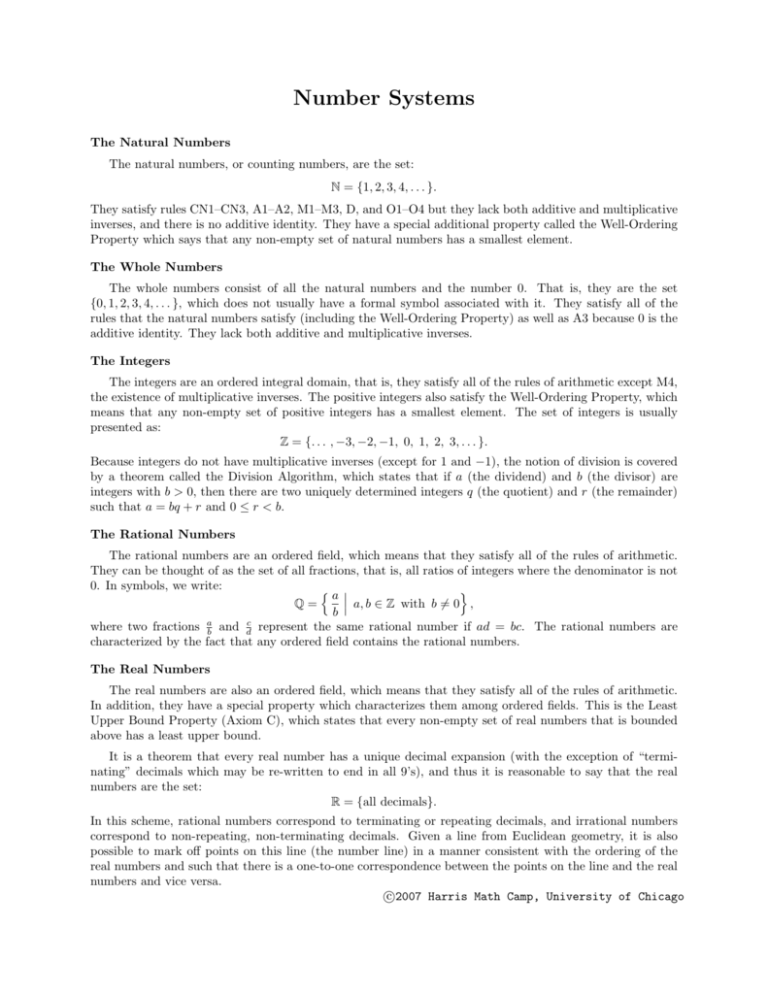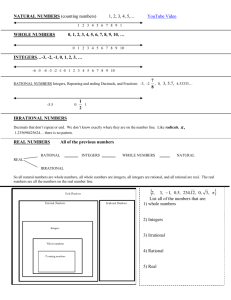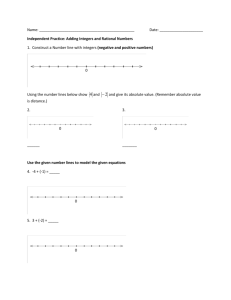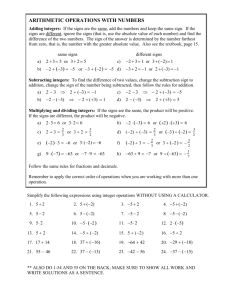Number Systems - University of Chicago
advertisement

Number Systems
The Natural Numbers
The natural numbers, or counting numbers, are the set:
N = {1, 2, 3, 4, . . . }.
They satisfy rules CN1–CN3, A1–A2, M1–M3, D, and O1–O4 but they lack both additive and multiplicative
inverses, and there is no additive identity. They have a special additional property called the Well-Ordering
Property which says that any non-empty set of natural numbers has a smallest element.
The Whole Numbers
The whole numbers consist of all the natural numbers and the number 0. That is, they are the set
{0, 1, 2, 3, 4, . . . }, which does not usually have a formal symbol associated with it. They satisfy all of the
rules that the natural numbers satisfy (including the Well-Ordering Property) as well as A3 because 0 is the
additive identity. They lack both additive and multiplicative inverses.
The Integers
The integers are an ordered integral domain, that is, they satisfy all of the rules of arithmetic except M4,
the existence of multiplicative inverses. The positive integers also satisfy the Well-Ordering Property, which
means that any non-empty set of positive integers has a smallest element. The set of integers is usually
presented as:
Z = {. . . , −3, −2, −1, 0, 1, 2, 3, . . . }.
Because integers do not have multiplicative inverses (except for 1 and −1), the notion of division is covered
by a theorem called the Division Algorithm, which states that if a (the dividend) and b (the divisor) are
integers with b > 0, then there are two uniquely determined integers q (the quotient) and r (the remainder)
such that a = bq + r and 0 ≤ r < b.
The Rational Numbers
The rational numbers are an ordered field, which means that they satisfy all of the rules of arithmetic.
They can be thought of as the set of all fractions, that is, all ratios of integers where the denominator is not
0. In symbols, we write:
o
na Q=
a, b ∈ Z with b 6= 0 ,
b
where two fractions ab and dc represent the same rational number if ad = bc. The rational numbers are
characterized by the fact that any ordered field contains the rational numbers.
The Real Numbers
The real numbers are also an ordered field, which means that they satisfy all of the rules of arithmetic.
In addition, they have a special property which characterizes them among ordered fields. This is the Least
Upper Bound Property (Axiom C), which states that every non-empty set of real numbers that is bounded
above has a least upper bound.
It is a theorem that every real number has a unique decimal expansion (with the exception of “terminating” decimals which may be re-written to end in all 9’s), and thus it is reasonable to say that the real
numbers are the set:
R = {all decimals}.
In this scheme, rational numbers correspond to terminating or repeating decimals, and irrational numbers
correspond to non-repeating, non-terminating decimals. Given a line from Euclidean geometry, it is also
possible to mark off points on this line (the number line) in a manner consistent with the ordering of the
real numbers and such that there is a one-to-one correspondence between the points on the line and the real
numbers and vice versa.
c
2007
Harris Math Camp, University of Chicago








